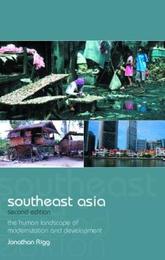
|
Southeast Asia: The Human Landscape of Modernization and Development
Paperback
Main Details
| Title |
Southeast Asia: The Human Landscape of Modernization and Development
|
| Authors and Contributors |
By (author) Jonathan Rigg
|
| Physical Properties |
| Format:Paperback | | Pages:408 | | Dimensions(mm): Height 234,Width 156 |
|
| Category/Genre | Development economics
Economic systems and structures |
|---|
| ISBN/Barcode |
9780415256407
|
| Classifications | Dewey:959 |
|---|
| Audience | | General | | Undergraduate | | Postgraduate, Research & Scholarly | | Professional & Vocational | |
|---|
| Edition |
2nd Revised edition
|
| Illustrations |
59 black & white tables
|
|
Publishing Details |
| Publisher |
Taylor & Francis Ltd
|
| Imprint |
Routledge
|
| Publication Date |
24 October 2002 |
| Publication Country |
United Kingdom
|
Description
The revised edition of Southeast Asia provides a grounded account of how people in the region are responding to - and being affected by - the changes sweeping through the region. The 'growth' or 'miracle' economies of Southeast Asia, after having achieved one of the most remarkable transformations in recent history, suffered a sharp downturn in fortunes with the Asian economic crisis of 1997. At the same time, the transitional economies of Indochina have undergone a deep process of market reform. This book unpicks the 'miracle' and the 'crisis' and elaborates on the process of reform. The first section of the book provides the conceptual and empirical background to the later chapters, by examining the various explanations for Asia's rapid growth, the implications of fast-track industrialization, the causes and interpretations of the economic crisis, and indigenous and alternative visions of development in the region including Buddhist and Islamic economics and the Asian Way. The second section focuses on poverty and social exclusion in the region from standard income-poverty studies to participatory methods that focus on more nuanced notions of deprivation. The third section of the book takes these trajectories down to the level of the padi field and the factory floor and asks a series of questions, including: How do people construct their livelihoods? What processes of marginalization are evident? What are the emerging relations between rural and urban areas, and between farm and non-farm work? The final section reviews the Southeast Asian growth experience in the light of the many critiques of modernization. Southeast Asia blends conceptual interpretations of the regions growth (and fall from growth) with case-study material drawn from across the region. It uses a wide range of social science literature and presents the complex arguments deployed in an accessible manner. The book challenges our understanding of patterns of change in rural and urban areas of the region, and unpicks the myriad ways in which individuals and households construct their livelihoods. Chapter summaries and annotated further reading are included.
Reviews'This text should be of great value to those interested in South East Asian development in particular and development studies in general and should stimulate lively debate.' - Geographical Journal 'For the student of Southeast Asia, development studies and development geography, this book provides a wealth of knowledge and insight into the inner workings of one of the world's most interesting and challenging regions. For their teacher, the book encapsulates a series of debates which will provide almost endless material for tutorial discussions' - ASEASUK News 'This book reflects many years of careful scholarship and committed engagement with the region, and, as benefits a Southeast Asianist, a genuine and realistic appreciation of the ways in which development and modernization are appraised by the peoples of Southeast Asia.' - The Geographical Journal, 2005
|